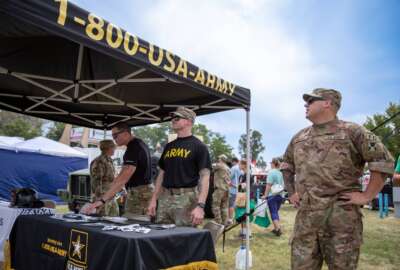DoD charges up to EV makers for the next great battery
A new collaboration between GM Defense and several government research entities looks to find the newest and best kinds of batteries.
As the Defense Department looks to utilize electric vehicles more and more, it’s leaning on EV makers and researchers for the newest and best kinds of batteries. A new collaboration between GM Defense and several government research entities looks to achieve that goal. To learn more about this project, the Federal Drive with Tom Temin welcomed Pete Johnson, Vice President of Business Development for Integrated Vehicles for GM Defense.
Interview transcript:
Tom Temin As the Defense Department looks to use more electric vehicles, it’s leaning on Evie makers and researchers to improve batteries. A new collaboration between GM Defense and several government research entities looks to achieve that goal. For details, Federal News Network’s Eric White spoke with GM Defense vice president Pete Johnson.
Pete Johnson We were asked to support this specific effort with the University of Texas at Arlington and their pulse power and energy laboratory, along with the Naval Surface Warfare Center, Philadelphia division. We’re leveraging, for this study, our GM’s ultium battery platform and its advanced propulsion architecture. It’s the same batteries we use in all of our commercial line of vehicles. The intent is for them to be evaluated and tested, so the research team can better understand the capabilities of these commercial automotive batteries and more importantly, to see how they might be leveraged for military and government use.
Eric White What, specifically, do you think that the DOD needs out of electric vehicles that maybe may not be necessarily a need for those commercial entities that you mentioned?
Pete Johnson Well, I think all of these studies are recognized, one, first and foremost, increased energy demand within the military and the challenge of moving energy around the globe to meet all these warfighter needs. The need for power on today’s battlefield is real. There’s been a proliferation of advanced sensors, communication systems, jammers, small drones, and even basic soldier kit that all increased power demands on soldiers in the field. You know, the U.S. Army has a great chart that shows the increasing energy demands at platoon level going all the way back to the early 1990s, where they deployed and supported Desert Shield Desert Storm to the present day, and to say that it’s a dramatic decrease understates the challenge of it. From 48 pounds of batteries to 1,100 pounds of batteries for each platoon and having hauled those rucksacks in my previous military career, I know exactly what that means to the team, and either have to sustain it by delivering for the mountains of batteries, or by employing really inefficient generators to recharge them. Generators, you know, are large, they’re bulky, they’re loud, they require fuel. Very, very challenging for all those teammates forward. And I believe in recognition of this, we’re supporting many DoD projects that help facilitate, first and foremost, testing of commercial technology to help solve this and many other power challenges.
Eric White What kind of infrastructure is required to recharge these batteries and make sure that they are actually useful and able to be maintained when you are out in the ford or on the edge of the battlefield? We’re speaking with Pete Johnson. He is the vice president of business development for integrated vehicles for GM Defense. So, let’s get down to the actual cost of all of this. Is having these edge of technology or cutting edge technology batteries, will that end up saving money in the long run? What is the undertaking for creating enough of these to actually make them of use for a DoD operation?
Pete Johnson It starts with commercial application, as you know, and even for that, I mean, at the forefront of the development of these batteries. It’s all about reliability, robustness, you know. Commercial companies also don’t want to be dealing with warranty issues and complications with their batteries. And, so, from the inception of a battery design, that is at the forefront, as well as safety. Wanting to make sure that they’re reliant, they’re reliable, they’re safe. These ultium batteries are modular, and they start with cells and chemistries or develop that one, maximize and optimize the available energy but also maximize the safety of that energy and then these sails are built and construction in modules. And then these modules are organized as part of larger battery packs, which creates a lot of different modular options for packaging. So, regardless of the application, you can change the orientation of either the cells or the modules, get four modules, six modules, eight modules, etc. and organize them stack them or stand them up in ways that allow for useful packaging. But what we want to do in partnership with the government is to go beyond the commercial testing and validations for reliability and safety and make sure that they are appropriate for the warfighter, who, as you know, not only has to deal with, you know, things operating, but they occasionally get shot at. And, so, that’s a key part of our effort is to certify these batteries and to make sure that they’re absolutely military grade and capable and useful for the warfighter. Yeah, well, we began with the economies of scale that we gained with the commercial applications and what we’re doing is we’re drawing from those economies and then applying that to well, you know, what is in fact small volume applications for the for the military. So, we’re certainly leveraging that. And the commerciality, by its very nature, brings value and savings for the U.S. taxpayer, you know, for sure. But we’re listening not only to the cost concerns, what we really do I mean, our focus is really understanding what the customer wants and needs. What are their challenges? What are their aspirations in improving capability? And it’s clear that beyond cost, they need to also reduce the amount of fuel that’s consumed and supportive of military operations. They do have, as I suggested there, a power gap at the tactical edge. And we know by listening not only to our U.S. military, but you can see what’s going on in Ukraine as a very, very good example of the type of warfare that we might anticipate in the future, that military units have to be increasingly more mobile and more capable, given the ever-present risk of being identified and targeted. And, so, we also know that U.S. military believes that they’re going to operate in a contested environment, meaning from the homeland to wherever they’ve got to deploy, they have got to reduce the amount of supplies going forward, because it’s all being contested. And last thing they want to do is spend all their resources protecting the supply line, when in reality, they really need to be operating in a more capable fashion, wherever the conflict is. To assist in this, we’re developing solutions in mobility and power production storage, intended to reduce that fuel consumption, enable the energy at the tactical edge, and to enhance the operational capability and protection of those forces. It all, I would say, wrapped around that, to your earlier point, is, there’s value here, right? There’s value when you can leverage the billions of dollars of research and development that our commercial parent company employs and executes before we even start working the military application. One innovative option is to provide, you know, military grade hybrid vehicles. Another is to smartly package the energy storage and existing vehicles like the infantry squad vehicle, and a third is tactical microgrids. You know, sometimes there are parts of the operation forward that are less mobile, but that need to operate with power. And right now, the only thing they have are generators. If it’s okay with you, I’d like to focus on the hybrid vehicle portion of that. The military grade solution that we’re developing is a rugged off road capable vehicle that delivers operational and sustainment advantage. And I think also is is economical for the for the U.S. taxpayer. It does employ an internal combustion engine that charges a battery pack that powers motors that ultimately propels the vehicle. You can still leverage, because it has an internal combustion engine, you can still leverage the existing fuel architecture. So you don’t have to recall all that investment, strategic and operational investment that the U.S. has made on moving fuel to the battlefield. And at the end of the day, it makes military forces better and more capable and it has silent drive and solid watch capabilities. That means it can drive for periods of time with internal combustion engine that’s charging, right? It’s charging the battery. And then when you want to, you can execute the solid drive capability, so you can move silently for extended distances. And then when you get to wherever you’re at and you’ve got to execute your mission, you can turn the engine off and just operate off battery power and run all of your systems silently.
Tom Temin Pete Johnson is business development vice president for GM Defense integrated vehicles. We’ll post this interview with federalnewsnetwork.com/federaldrive. Hear the Federal Drive on demand. Subscribe wherever you get your podcasts.
Copyright © 2024 Federal News Network. All rights reserved. This website is not intended for users located within the European Economic Area.
Tom Temin is host of the Federal Drive and has been providing insight on federal technology and management issues for more than 30 years.
Follow @tteminWFED







